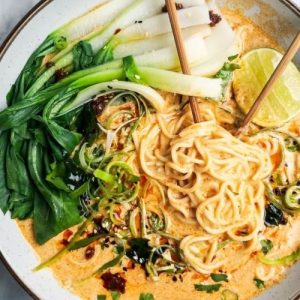
20-Minute Vegetarian Coconut Noodles
A quick, one-pot noodle dish featuring a creamy coconut broth enriched with gochujang, garlic, ginger, and lemongrass. Fresh pak choi, scallions, and cilantro bring freshness and nutrition, while noodles soak up the spicy, saucy goodness. Ready in just 20 minutes, this comforting meal is wholesome, customizable, and perfect for weeknight cooking.
Equipment
- 1 large saucepan or pot
- 1 Wooden spoon or spatula
- 1 sharp knife
- 1 cutting board
- 1 citrus squeezer (optional, for lime)
- 4 serving bowls
Ingredients
- 2 tablespoons gochujang paste
- 1 tablespoon soy sauce
- 2 teaspoons fish sauce or vegan alternative/more soy sauce
- 2 tablespoons chili oil plus extra for serving
- 2 garlic cloves crushed
- 1 tablespoon fresh ginger grated (or 2 teaspoons ginger paste)
- 1 lemongrass stalk lightly crushed and cut into 3 pieces (or 1 tablespoon lemongrass paste)
- 400 ml 14 oz can coconut milk (choose one with >60% coconut extract)
- 1.2 liters 5 cups vegetable or chicken stock
- 200 g 7 oz noodles of choice
- 2 heads pak choi sliced
- 4 scallions spring onions, finely sliced
- Small handful fresh cilantro coriander leaves
- 1 lime cut into wedges
Instructions
- Build the Flavor Base: Place a large saucepan or deep pot on the stove and set it over medium heat. Add the gochujang paste, soy sauce, fish sauce (or vegan substitute), and chili oil. Stir these ingredients together for about 1–2 minutes, letting them warm through and release their rich, spicy aroma. Next, add the crushed garlic and grated ginger. Stir continuously so they don’t burn—this gentle cooking will unlock their natural fragrance and give the dish its signature depth of flavor.
- Prepare the Coconut Broth: Once the aromatics smell fragrant, pour in the coconut milk along with the pieces of lemongrass. Follow this with the vegetable or chicken stock. Stir thoroughly to blend the chili base with the creamy coconut milk, creating a smooth, vibrant broth. Allow the mixture to come up to a gentle simmer, then reduce the heat slightly and let it bubble quietly for about 5 minutes. This resting simmer allows the lemongrass and spices to infuse the broth with brightness and complexity.
- Cook the Noodles in the Broth: After the broth has developed its flavor, add the noodles directly into the pot. Stir well so they don’t clump together, and check the packet instructions for the recommended cooking time. Most noodles will need about 4 minutes, but times vary depending on type and thickness. As the noodles cook, they will absorb the spicy coconut broth, becoming silky and flavorful. Stir occasionally to ensure even cooking and to prevent sticking at the bottom of the pan.
- Add Fresh Vegetables for Balance: When the noodles are nearly done, add the sliced pak choi into the simmering broth. Gently stir to coat the greens in the hot liquid. Within just a minute, the pak choi will turn bright green and tender while still retaining a slight crunch—this keeps the dish both fresh and nutritious. Immediately remove the pot from the heat to avoid overcooking the vegetables, which could cause them to lose their vibrant color and crisp texture.
- Assemble the Noodle Bowls: Divide the noodles and pak choi evenly into four serving bowls. Ladle plenty of the coconut broth over each portion, making sure every bowl gets a generous amount of sauce. The noodles should be saucy rather than soupy—creamy enough to cling to the noodles, yet brothy enough to sip.
- Add Garnishes and Final Touches: Finish each bowl with freshly sliced scallions and sprigs of cilantro for a burst of color and freshness. Squeeze a wedge of lime over the top to cut through the richness of the coconut milk with a refreshing citrus zing. For extra heat and flavor, drizzle a little more chili oil across the surface. Serve immediately with additional lime wedges on the side, so everyone can adjust the acidity to their liking.
Notes
- Customize Your Protein: This recipe is very versatile. For a plant-based version, stick to tofu or edamame. If you prefer animal protein, cooked chicken, shrimp, or even thinly sliced beef can be added directly to the simmering broth with the noodles.
- Vegetable Variations: While pak choi is traditional, feel free to swap or add other greens like spinach, bok choy, snow peas, or green beans. Add denser vegetables earlier in the cooking process to ensure they soften properly.
- Noodle Choices: Any noodles work here—ramen, rice noodles, udon, or whole-grain spaghetti. Adjust cooking time according to the type, as thicker noodles will need longer to soften.
- Adjusting Heat Levels: Gochujang paste is spicy, but you can tailor the heat by adding less chili oil or substituting with a milder chili paste or sriracha.
- Coconut Milk Tips: Use full-fat or at least 60% extract coconut milk for a creamy texture. Shake the can before opening to mix the solids and liquid for even consistency.